The Sandy war memorial stands next to the recreation ground on Bedford Road. It contains 126 names of Sandy men killed in the First World War. The size of Sandy, including its hamlets was 3,377 in the 1911 census. Of these men 53 were killed serving with the Bedfordshire Regiment. Bedfordshire and Luton Archives and Records Service has the war diaries of each of the battalions of the regiment to see active service. The numbers of Sandy dead for the Regiment each year are as follows:
1916 saw an equivalent number of men with Sandy connections killed to the first two years of the war put together. The deaths began early, on the 4th January 1916 saw the death of Private George Webb, a member of the 8th Battalion, which had gone out to France in August 1915. George had been born in Gamlingay [Cambridgeshire] and lived in Everton, though he enlisted in Sandy. On the day of his death his unit was in trenches at a place called Forward Cottages near Vlamertinge, north-east of Ypres. The battalion had taken up its positions the previous afternoon and were well established by 9.30 p. m. The war diary noted: "trenches very muddy and wet". The day Webb died the diary simply stated: "Raining and blowing very hard". Entries for the following few days mention shelling and so it was presumably this that accounted for poor George. He is buried at La Brique Military Cemetery Number 1 which stands not far from where he was killed.
On 31st March 1916 Corporal Alfred Wheatley of the 1st Battalion died of wounds. He had been born in Beeston but lived in Langford. He is buried at Faubourg d'Amiens Cemetery at Arras. He is probably one of the three other ranks recorded by the battalion war diary as having been wounded in a tour of the front line trenches north-east of Arras from 27th to 31st March inclusive. The diary states: "Indifferent Trenches owing to shallowness of Trenches and consequent exposure to view of enemy. Much work required to render them safe. Enemy active with aerial Torpedoes and trench Mortars". It is thus likely that Wheatley was wounded by an aerial torpedo or trench mortar burst. There are interesting entries for 29th and 30th March which show that being in the front line was not just a matter to standing in trenches but of patrol work in no man's land too. "Lieutenant Whittemore, on patrol with Sergeant Quince (a Sandy man, see below) and Private Winch, A Company, mortally wounded on patrol. In spite of efforts by these men to bring back the body under rifle and grenade fire, it was impossible to recover the body". The next entry reads: "Search party for body of Lieutenant Whittemore proved futile". Not surprisingly, Whittemore, unlike Wheatley, but like so many others, has no known grave.
The Battle of the Somme began on 1st July 1916. It was the largest British offensive of the war so far, designed to break through the German lines east of the town of Albert and seize the town of Bapaume. The casualties on the first day of the battle were the worst on any single day of the British army's history - 19,240 killed, 35,493 wounded, 2,152 missing and 585 taken prisoner. The battle developed into a brutal slugging match with occasional small breakthroughs, but by early November, when the battle was called off Bapaume had not been reached. Each side suffered around half a million casualties.
On 27th July 1916 Sergeant Edward Quince of 1st Battalion, who had tried to recover Lieutenant Whattemore's body in March, was killed in action. He had been born in Sandy and his regimental number was 8765, indicating that he had joined up between September and December 1906. Numbers 8764 and 8766, were Charles William Braybrooks and Walter Emery, both from Sandy, had been killed in 1914 and it seems reasonable to assume that all three had joined up together. Quince has no known grave and is commemorated on the Thiepval Memorial to the Missing. He had been Gazetted for the Military Medal for bravery in the field on 3rd June, perhaps for the Whattemore incident or for his patrol work in general.
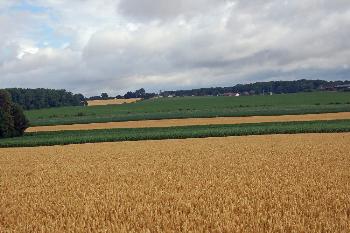
View from the Guillemont Road towards Longueval July 2009
The 1st Battalion were near the village of Longueval at the end of July and on 27th they took part in an attack. The 1st Battalion Norfolk Regiment was to assault the German trenches with the Bedfords acting as reserve until the first two lines had been taken at which point the Bedfords were to attack the third line.
The Battalion arrived at its assembly point at 3.50 a. m. going over the top at 7 a. m. following the Norfolks and occupying reserve trenches at Longueval, which the Norfolks had helped to capture. Forty minutes later they received a message from the Norfolks that they needed help because of heavy shelling. Two companies from the Bedfords thus joined the Norfolks in assaulting the second line around 9 a. m. but were held up by machine gun fire and forced to dig in near the road from Longueval to Flers. Total casualties in the two assaulting battalions were 4 officers and 160 other ranks out of a combined total of 10 officers and 342 other ranks - just over 45% of their strength. Thus the attack was partially successful but did not attain all its objectives, a familiar story in the Great War. The battalion was withdrawn next day.
The Brigadier put a brave face on things in a congratulatory message to his men: "The Brigadier-General Commanding wishes to express to all ranks of the Brigade his great admiration at the magnificent manner in which they captured the Village of LONGUEVAL yesterday. To the 1st NORFOLK Regiment and the 1st BEDFORDSHIRE Regiment and some of the 16th ROYAL WARWICKSHIRE Regiment, who were able to get into the enemy with the bayonet, he offers his heartiest congratulations. He knows it is what they have been waiting and wishing for for many months. The 1st CHESHIRE Regiment made a most gallant and determined effort to reach their objective and failed through no fault of their own. The way in which the Troops behaved under the subsequent heavy bombardment was worthy of the best traditions of the British Army. The Brigade captured 4 Officers and 159 other ranks".
On the night of 30th-31st the Germans launched a series of counterattacks against Longueval and, just after midnight began an intense bombardment of the line held by the Bedfords, who were to advance to support a battalion of the King's Own Scottish Borderers which was in difficulties. In the confusion guides could not be found to take the Bedfords to their position and they improvised a defensive line. By 2.30 a. m. all four companies reported heavy casualties. Nevertheless their defences held and they relieved around midnight on the night of 31st July-1st August. Casualties in this action amounted to 10 officers and 188 other ranks. One of the latter was Private Ernest John Endersby, killed on 31st. He had been born in Girtford and lived with his wife Elizabeth at Pym's Cottages in Bedford Road, he was 36 years old. Like Edward Quince he has no known grave and is commemorated on the Thiepval Memorial.
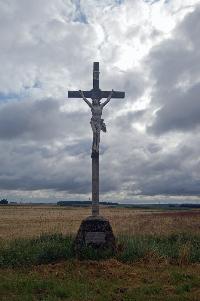
Croix de Maltzkorn July 2009
On 30th July the 2nd Battalion had made an attack in the direction of Guillemont in which Private Lawrence William Huckle was killed. The battalion had taken a minor role in support on the first day of the Battle of the Somme in which its Division, 30th, had been one of only two to take all its objectives. Early in the morning of the 30th A Company attacked Maltzkorn Farm near the southern end of Trônes Wood (Bois des Troncs in French) south-west of Guillemont. A cross now marks the sight of the farm. At this time the company was on the extreme right of the British Army in France and took the shattered remains of the farm in conjunction with a French unit. The war diary notes: "The attack was a Brilliant success, from 70 to 80 Germans being killed in [Maltzhorn] Trench, and one Prisoner taken. The Farm itself was found not to be held". They suffered about thirty casualties and rejoined the rest of the battalion which was to act as a reserve to other battalions attacking in the direction of Guillemont. The attack was severely hampered by a dense fog causing the attacking battalions to lose touch with one another. At about 6.30 a. m. they called for reinforcements. Orders were the given for B and C Companies of the Bedfords to move up in support, but these companies were stopped by the officer commanding 17th Battalion King's (Liverpool) Regiment on reaching him, as he could get no information from officers commanding 19th and 20th Kings Liverpools Regiment as to where the support was required.
At 10 a. m. A Company were sent off to get touch with the French again. They got in touch with them and found that they had also been held up and were digging in. A Company therefore dug in on their left just south of Maltzkorn Farm. At about 1.30 p. m. orders were received to consolidate the position held and the attack was called off, the whole position being heavily shelled throughout the day. The battalion was relieved at 8 p. m. having lost 6 officers and 186 other ranks killed, wounded and missing. Huckle had been born and still lived in Sandy and has no known grave, being commemorated on the Thiepval Memorial.
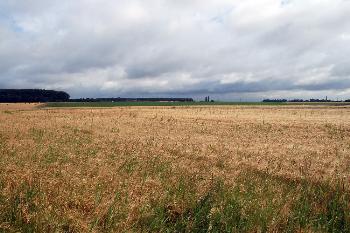
View from Croix de Maltzkorn along the line of consolidation July 2009
At the end of September the 18th (Eastern) Division captured the village of Thiepval. This had been a target of the attack on the 1st July - 115 days previously. 54th Infantry Brigade captured most of the village on 26th September. Private Albert Jefferies of 7th Battalion, which had arrived in France in July 1915 and played a leading part in the attack of 1st July, when it achieved all its objectives, was killed on this day. He had been born and still lived in Sandy. The Bedfords took no part in the attack on that day, remaining in reserve. It seems likely, therefore, that Private Jefferies was killed by a stray shell, certainly his body was never identified and, having no known grave, he is commemorated on the Thiepval Memorial.
The following day, 27th, the 7th Battalion had a moment of glory, capturing the last part of the village of Thiepval at the point of the bayonet. The war diary reads: "The morning was extremely dark and the assaulting companies had great difficulty in forming up for the attack on the correct alignment. At about 5.45 a. m. all was ready and a few minutes later the two lines advanced sweeping across the untaken portion of Ground and trenches. Two machine guns and a good deal of rifle fire opened from the enemy's lines but our troops continued to advance and in a short time were in possession of the German trenches on the north-western face of Thiepval …. during this action 36 prisoners were taken and about 100 Germans killed by rifle fire and bayonets. This action though apparently small was of the utmost importance as without the whole of the village of Thiepval and the trenches surrounding it being captured the whole Line of Attack was held up. So to the 7th Bedfords (especially C and D Companies) belongs the honour and Glory of the final destruction of one of the Germans' strongest positions and one which they had boasted could never be taken. Our casualties were 2 officers and about 110 other ranks in the above action".
One of these casualties was Private Percy Harry Wright, aged 21, who had been born in Sandy. His parents, Arthur and Jane, lived in London Road and his widow, Helen Mary lived at 2 Pyms Cottages, making him a neighbour to Ernest Endersby, killed with the 1st Battalion on 31st July. His body was never found or identified and he is commemorated on the nearby Thiepval Memorial.
The next day the 7th Bedfords took part in an assault on a German stronghold called the Schwaben Redoubt, lying on a spur of land north-east of the village. The assault was made by a number of divisions and the Bedfords' line of attack lay through the communal cemetery and the angle of the road to Grandcourt and a track to Saint-Pierre Divion. This track was the axis of the advance which began at 1 p. m. The diary notes: "The forming up by mid-day was an exceedingly difficult operation as the trenches in question were in full view of the enemy and the light was very good. It was however successfully carried out". The right most platoon, of A Company was virtually wiped out by machine gun fire from the redoubt but the advance continued albeit rather too much to the left of the intended line due to pressure from the battalion attacking on the Bedfords' right, shying away from the fire which had so affected A Company. The whole attack was reasonably successful but failed to take the whole of the Redoubt, the last portion of it not falling until the following month. The fighting lasted all through the day and into the next morning with strong German counterattacks.
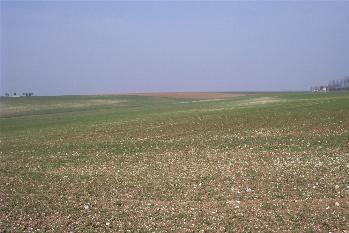
Looking towards the site of the Schwaben Redoubt from Thiepval March 2004
Temporary 2nd Lieutenant Tom Adlam of the Bedfords won the Victoria Cross for his actions at Thiepval. The war diary notes: "2nd Lieutenant Adlam organised a strong party, told the men to cheer and they charged the strong point with him as leader, in one big rush, overbore all resistance and completely wiped out the enemy". It also notes: "The courage, resolution and endurance displayed by all ranks was quite wonderful. They were out to kill and the Battlefield is a witness that they carried out to the full their intentions".
Another Sandy man was killed on this day, Private Thomas James Payne. He was 32 years old and had been born in Sandy to John and Sarah. His widow Dorothy lived in London Road. Again, sadly, he has no known grave and is commemorated on the nearby memorial.
On 13th November the Battle of the Somme was still dragging on. That day saw an attack by the Royal Naval Division, a unique formation, two brigades of which were composed of Royal Marines and sailors not needed by the Fleet. The other brigade comprised four battalions from the army, one of which was 4th Battalion, Bedfordshire Regiment. The attack took place on the north bank of the River Ancre near Beaumont-Hamel, another objective which should have been taken on 1st July. In the attack, in which the division captured the village of Beaucourt, 9 officers and 57 other ranks were killed and 5 officers and 108 other ranks wounded, with 16 other ranks reported as missing. Conditions were appalling with the ground a sea of mud, encouraging grimly humorous remarks that only the Navy could be expected to operate on it. On that grim day Private James William Brown, who had been born in Sandy but had then moved to Northill, was killed in action. Like so many others, his body was never found and he is commemorated on the Thiepval Memorial.
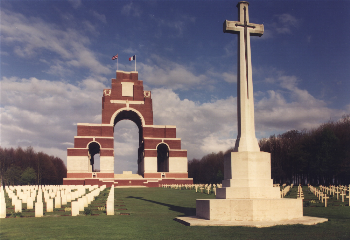
The Thiepval Memorial
The final death in 1916 was that of Private Richard Bertram Wagstaff of the 2nd Battalion on 6th December, He had been born in Bedford but was then living in Sandy. He died of wounds and is buried in WarlincourtHalteBritishCemetery at Saulty between Arras and Doullens. This location shows that he died at either 20th or 43rd Casualty Clearing Station. On 4th December the battalion had left its billets at Humbercamps and had entered the front line trenches near Berles-au-Bois. The next day eight other ranks were wounded and it seems likely that Private Wagstaff was one of them, struck by a bullet or a shell splinter.